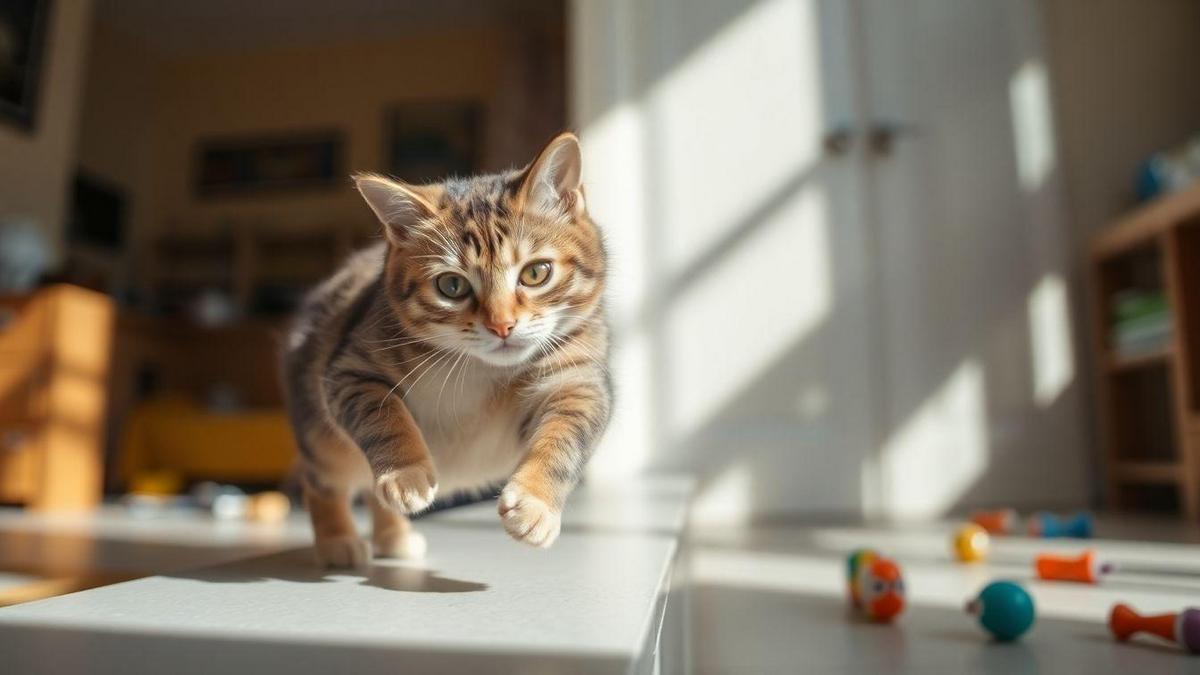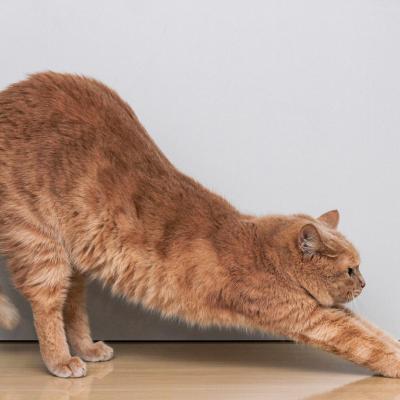Anúncios
Cats are fascinating animals known for their incredible agility and balance. One striking ability is their capacity to always land on their feet, even after unexpected falls. This characteristic sparks curiosity and interest in the science behind feline behavior.
The phenomenon known as the righting reflex involves unique aspects of cat anatomy and physiology. They can rotate their bodies in midair to position themselves correctly before touching the ground. Understanding this process reveals essential evolutionary adaptations for the survival of felines.
Anúncios

Understanding the Science behind the Cat’s Righting Reflex
Cats are known for their incredible agility and unique ability to land on their feet after a fall. This phenomenon, often called the “righting reflex,” is a fascinating aspect of feline biology that intrigues pet owners and enthusiasts alike. The righting reflex allows cats to rotate their bodies in the air, ensuring they orient themselves correctly before hitting the ground. This remarkable skill is not just a trick; it plays a crucial role in their survival and well-being.
The science behind this reflex involves a combination of anatomy, physiology, and physics. Cats have a flexible spine and a unique skeletal structure that allow them to quickly rotate their bodies. Additionally, the inner ear, which helps maintain balance, plays a significant role in cats’ ability to right themselves during a fall. Understanding how cats achieve this not only increases our appreciation for these animals but also clarifies the evolutionary adaptations that have enabled them to thrive in various environments.
The righting reflex and its role in balance
The righting reflex is an innate behavior in cats, activated as soon as they begin to fall. It allows the cat to rotate the rear and front parts of the body separately. This way, the animal can position itself to land on its paws.
This reflex depends on sensory input from the eyes and the inner ear, which maintains balance. The cat quickly adjusts its muscles to perform the necessary body rotation. These movements are coordinated to minimize the impact of the fall.
Furthermore, the righting reflex does not occur instantly, but within fractions of a second. The speed of this response is crucial to ensure the cat has enough time to adjust. This makes all the difference in the safety of the landing.
Cat anatomy: How body mechanics help in falls

A cat’s spine is extremely flexible, facilitating twisting movements in midair. This flexibility is greater than that of many other mammals, allowing body rotation. The lightweight bone structure also helps reduce the force of impact.
Cats have loose shoulders that can rotate independently from the pelvis. This anatomical feature facilitates righting even in short spaces. Combined with flexibility, this structure allows the body to adapt quickly.
Moreover, cats’ muscles are agile and strong, supporting rapid and precise movements. The active musculature aids in executing the reflexes and ensures control during the fall. This increases the ability for a safe landing and minimizes injuries.
Advantages of cats landing on their feet: The benefits of feline agility for survival
The ability of cats to land on their feet offers several advantages that contribute to their survival in the wild. This remarkable skill is not merely a product of luck; it has evolved over millions of years, allowing felines to navigate their environments with grace and precision. One of the main benefits of this ability is the reduced risk of injury when falling from heights. Cats are curious creatures, often exploring high places, and their righting reflex minimizes the chances of serious injuries during accidental falls.
Additionally, landing on their feet allows cats to maintain their balance and composure even in precarious situations. This agility is essential for their hunting ability, enabling them to pounce on prey with accuracy and efficiency. A cat that can land on its feet quickly regains its balance and continues the chase, increasing its chances of securing a meal. This agility is vital not only for hunting but also for escaping predators, making it a crucial aspect of feline survival.
Besides physical advantages, the righting reflex also contributes to a cat’s psychological well-being. Cats are naturally more confident and exploratory when they know they can rely on their agility to navigate their environments. This confidence fosters a sense of security, encouraging them to engage in natural behaviors such as climbing, jumping, and exploring. Ultimately, the ability to land on their feet improves a cat’s quality of life, allowing them to thrive both in domestic and wild settings.
Moreover, the righting reflex is a testament to cats’ evolutionary adaptations. Over time, felines have developed a unique set of characteristics that allow them to excel in their environments. The ability to land on their feet is just one example of how nature has shaped their physiology to improve their chances of survival. Understanding these advantages not only deepens our appreciation for cats but also highlights the intricate relationship between anatomy, behavior, and environmental challenges.
How cats always land on their feet: Key mechanisms and techniques
The mechanics behind cats’ ability to land on their feet involve several key factors that work harmoniously together. The first component is the righting reflex, an innate behavior that allows cats to reorient themselves during a fall. This reflex is triggered when a cat is in free fall, allowing it to rotate its body and position its paws downward. The righting reflex is a complex process involving sensory input from the eyes and inner ear, coordinating muscle movements to achieve the desired orientation.
Another crucial aspect of feline balance is their unique anatomy. Cats have a flexible spine that allows for a greater range of motion compared to other animals. This flexibility enables them to twist and turn their bodies in midair, facilitating the righting process. Additionally, their lightweight skeletal structure reduces the impact of falls, allowing them to absorb shock more effectively. The combination of a flexible spine and light bones is a significant advantage when it comes to landing on their feet.
Feline reflexes also play a vital role in how cats navigate their environment. Cats have highly developed proprioception, which is the ability to sense the position and movement of their bodies. This heightened awareness allows them to make quick adjustments during a fall, ensuring they land on their feet. Their reflexes are fast and precise, enabling them to respond to changes in their surroundings with remarkable speed. This agility is not only beneficial during falls but also enhances their overall locomotion, making them skilled hunters and climbers.
The physics of how cats fall safely is another interesting aspect of their righting reflex. When a cat falls, it instinctively spreads its legs, increasing its surface area and creating drag. This technique slows their descent, reducing the impact upon landing. Additionally, the distribution of their body weight helps stabilize them during the fall, allowing for a smoother landing. Understanding the physics behind a cat’s fall provides valuable insights into the evolutionary adaptations that shaped their behavior and physiology.
Finally, the survival skills associated with landing on their feet cannot be overlooked. In the wild, cats often find themselves in precarious situations, whether climbing trees, jumping from heights, or escaping predators. The ability to land on their feet is crucial for their survival, as it allows them to navigate their environment confidently. Furthermore, this skill enhances their hunting capabilities, enabling them to pounce on prey with precision and agility. Overall, the combination of the righting reflex, anatomy, reflexes, and physics contributes to the remarkable ability of cats to land on their feet.
The righting reflex and its role in balance

Cat anatomy: How body mechanics help in falls
Feline reflexes and their impact on cat locomotion
The physics of how cats fall safely
Cats’ survival skills: Why landing on their feet is crucial
Understanding cats’ body mechanics for better agility
Cats have evolved a series of mechanisms and techniques that allow them to land on their feet, demonstrating their incredible agility and adaptability. The righting reflex is a fundamental component of this ability, enabling cats to reorient themselves during free falls. Additionally, their unique anatomy, including a flexible spine and lightweight bones, contributes to their capacity for safe landings. Feline reflexes and an understanding of physics further enhance their agility, making them skilled at navigating their environments. These skills are crucial not only for survival but also enrich their quality of life, allowing them to explore and interact with their surroundings confidently.
Frequently Asked Questions
How do cats always land on their feet?
Cats have a special reflex. They rotate their body in the air. This way, they manage to get on their feet when they fall.
What is the righting reflex?
It is a trick cats use. They use their sense of balance. This helps to rotate the body during the fall.
Do they always land on their feet?
Almost always! Cats are very agile. But if they fall from very high places, even they can get hurt.
Do cats feel pain when they fall?
Sometimes, yes. Falling from lower heights is safer. But there is always a risk of injury.
How can I know if my cat is safe at home?
Keep windows and balconies closed. Pay attention to where your cat jumps. This way, you can avoid dangerous falls.
